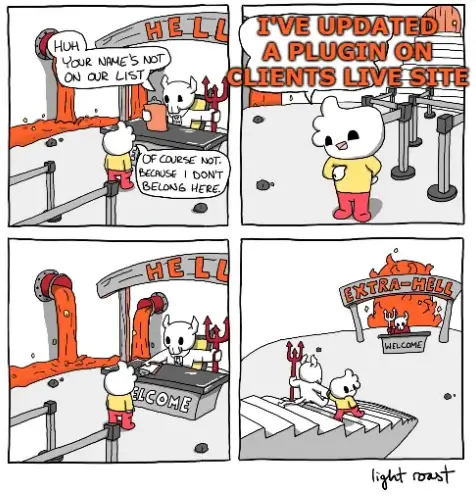
Ah, the familiar dance with WordPress updates—where confidence meets catastrophe, and where even seasoned pros like you get a swift reminder that the universe loves a good laugh at your expense.
Picture this: You’re in the zone, sipping your coffee, gazing at your client’s WordPress dashboard. There it is, a shiny new update for that swanky plugin you’ve rolled out across all your client sites. You skim the changelog, shrug, and think, “No big deal. I’ve done this a gazillion times. Staging site? Testing? Pfft, who needs it?”
With the click of a button, you initiate the update. The progress bar does its little dance, and soon enough, the screen proudly declares, “Updated.” You breeze through the plugin’s new settings. Everything looks peachy.
“This was a breeze!” you mutter to yourself, feeling like a digital maestro who’s just conducted a flawless symphony.
But then, with the confidence of a seasoned daredevil, you check the front page of the site. And there it is—a stark, soul-crushing void. A blank page. Panic hits you like a ton of bricks. The kind of panic that makes you wonder if you accidentally unplugged the internet for the entire world.
Before you can even process the disaster unfolding in front of you, your phone starts blaring. It’s your client, and they’re not in the mood for small talk. They’re ranting about emails going AWOL, orders vanishing into thin air, and a marketing campaign that’s gone as haywire as a toddler on a sugar high.
You swallow hard, realizing that the digital apocalypse is, indeed, your doing.
But of course, you can’t confess that to your client. Instead, you put on your best “I’ve got this under control” voice, assure them you’ll fix it, and hang up. Inside, though, you’re spiraling. Everything’s been smooth sailing until now, but suddenly, it feels like you’re in the middle of a hurricane, without a life jacket.
Desperation kicks in. You attempt the classic “rename the plugin folder via FTP” trick. Nothing. Zilch. The website’s been down for fifteen minutes, and you’re starting to sweat bullets.
It’s time to pull out the big guns—debugging mode. But wait, you suddenly remember those pesky permission issues you’ve been ignoring. Debugging isn’t going to play nice without them being fixed. Excellent timing, right?
But with the clock ticking louder than your heartbeat, you dive in anyway. You enable debugging on the front end, fully aware that you’re playing with fire. You reload the site and brace for impact.
Finally, an error message pops up—except it’s not the friendly nudge you were expecting. Nope, it’s a fatal error, and it’s referencing a function that, to your horror, doesn’t even exist in the WordPress source code.
“What fresh hell is this?” you mutter, as you dive headfirst into the tangled mess of code.
But you’re determined to solve this. You have a feeling that you’re close. You try something desperate. You go directly into the website’s heart and open the file that’s causing the error. You modify the code and upload it to the theme directory.
You reload the website, hoping that it’s the last time. And finally, the customer’s logo appears on the screen and the website loads without any issues.
Relieved, you feel as though a weight has been lifted from your shoulders. But you realize that you still have to explain to your customer why you updated a plugin on their production website without testing it first.
As you grab your jacket and prepare to head out, the nagging thought lingers: maybe, just maybe, you’ve made a colossal mistake. But hey, what’s a little existential dread in the grand scheme of things? At least the site’s back up, right?
